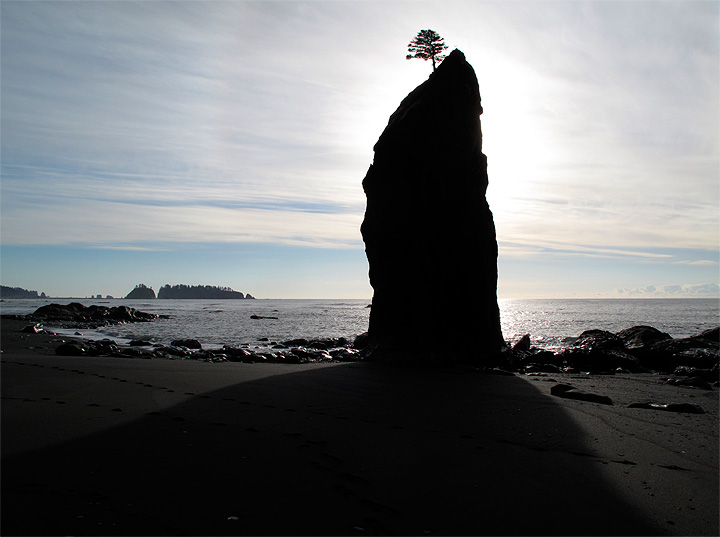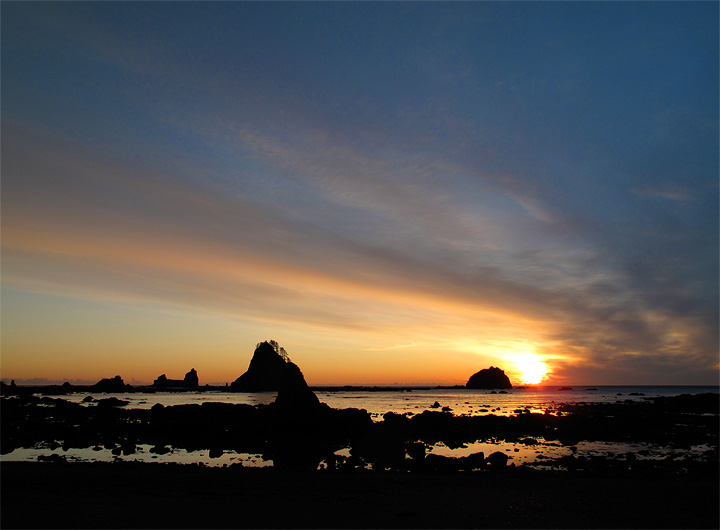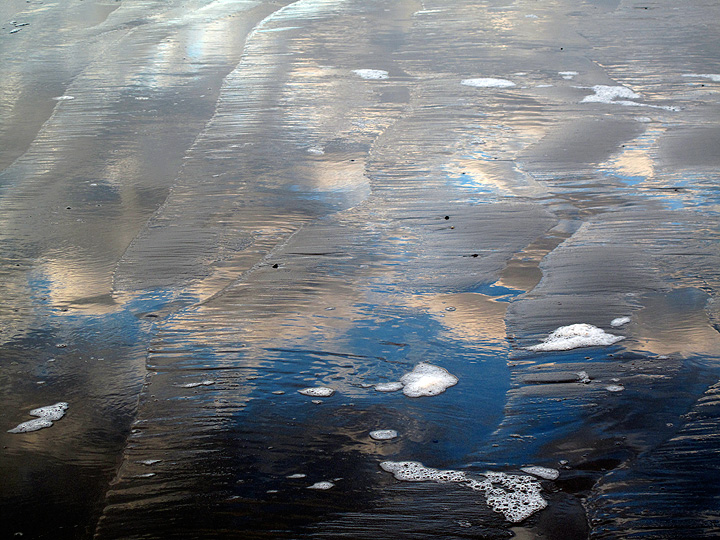

 |
 |
Kathy and Mark take a hike, the Olympic Coast • December 3 - 5, 2010
When we were teenagers, oh, so many years ago, our parents amazingly allowed us to wander the hills and valleys of Washington's natural wonders. Several of those trips were to the Wilderness Coast of the Olympic National Park, a 50-mile long strip of wild Pacific beaches and headlands accessible only at either end or from the small town of La Push, roughly in the center. These backpacking trips, usually 3 or 4 days in length, are some of our best memories from that time. For years, now, we have frequently thought "we should do one of those hikes again". And this year the stars aligned (though not the moon, but more on that later) and we were blessed with 3 days of fine weather in early December, a not-so-frequent occurrence. |

We decided on the more northerly of the two most wild sections of coast; beginning at Rialto Beach, near La Push and ending at Sand Point, some 25 miles further north. We bought food, fuel and boxed wine for two or maybe three nights out. Like many a trip to the Olympic Peninsula, ours begins with a ferry ride, this one from Edmonds, on the mainland, just north of Seattle, and landing in Kingston, on the Peninsula. |

After checking in with the Park rangers in Port Angeles and picking up our permit and bear-proof canister (more to combat the raccoons than their larger and more fearsome colleagues) we continued to the Rialto Beach to begin our walk. |

The rangers had told us that, aside from either end of the hike, there was a good chance we would see nobody else. And this in fact, was the case. Even with the mild and generally sunny weather, hiking on the Pacific Coast in December is apparently not everyone's cup of tea. |

Slippery walking as we pass through a natural arch near the north end of Rialto Beach. |

What with the drive, getting our permit, and a generally "relaxed" attitude, we did not start walking until the afternoon. But with the December sun so low in the sky, even at mid-day, the shadows had some length to them. |

Conditions were perfect. The ocean was relatively calm and we had a light off-shore breeze. |

Back to the problem with the moon... Well, the tides were not really in our favor. On this walk, tides rule your life. There are some headlands that you can't pass at high tide, and even walking on the log-strewn beach at high tide was all but impossible. The timing of passing certain obstacles was not ours to decide. Here's a quick tidal explanation for all you land-lubbers. There are two high tides and two low tides each day. So the transition from a high tide to a low tide takes about 6 hours (more like 6 hours and 10 minutes, but who's counting?). Often, one of the daily high tides is much higher than the other. The same can sometimes be said for the low tides, with one much lower than the other. Well, on our hike, the highest high tide, was at about 11 in the morning, and the lowest low tide was at about 5 in the afternoon. Doing the math, you can see that the not-so-high high tide would occur at a not-very-useful 11 at night, and the also not-very-helpful not-so-low low tide occurred at about 5 in the morning. Congratulations if you have stayed with me so far. The upshot is that the only really good time for walking was about the 2 to 3 hours just before sunset. Not very convenient. |

With all the rain of the previous few days, all the rocks were at their slippery-best. Getting hurt just sliding off a small boulder was perhaps the greatest risk. |

Just before sundown we reached the beach at the Chilean Memorial. The half-day's walk from Rialto Beach had been wonderful. The tide heading out, and out, and out, mostly clear skies and hardly a breath of wind. |

After setting up our tiny tent and preparing bed, Kathy worked on dinner while Mark struggled to find a scrap of wood that was not completely saturated with water. In the end he failed. But he did find all manner of flammable flotsam and jetsam. Some solid petroleum products apparently burn much better than others. We learned that styrofoam not only stinks, but is hard to light. It will, however, keep a good fire going. Polypropylene rope is pretty much useless as fire starter. The best fire starter turned out to be those PET drink bottles that are so unhelpful to the environment. Get out your Swiss Army Knife (we lacked anything bigger) slice up a bottle or two into strips and lay them in with your wet kindling. Once you get a flame going, the melting plastic oozes down into the wood and is more than enough to eventually get the wood dried out. Continue with bigger pieces of wood, throw in another bottle or two, a hunk of styrofoam, or perhaps a Barbie Doll (untimely victim of a container lost at sea) and before long, real wood, even if soaking wet, is enough to keep things going. Actually, all this "fire starter" was one of the sadder facts of this hike. Though our memories may be faulty, we certainly did not recall the sheer volume of trash that has washed up on the coast. Most of it appears to be related to the fishing industry–floats, tangled knots of rope and other buoyant boating odds and ends. I suppose it will just get worse and worse, as this stuff is amazingly resistant to even the pounding force of the ocean waves. |

So, though we had easy walking the afternoon of day 1, we knew that if we had a hope of finishing this walk, we had to start our second day's walk early. Really early. I don't remember what time we got up, but is was hours before dawn, on a pretty much moonless night. But if we wanted to get around some critical headlands, we needed an "alpine" start. We woke up, packed up, put off breakfast until later, shouldered our packs and started walking by headlamp. Things were going well, strolling along in the dark, chatting about this and that, when the big rock that Kathy was about to step on suddenly erupted in an alarmed cacophony of loud and quite intimidating barks and yelps. We jumped back, also with a little yelp of our own, while the big sea lion, rather ungracefully made a beeline for the water, some 15 meters away. I don't know who among us was the more startled. Slowly, the light came up, and along with it, the tide. Somewhere around the small headland of Saddle Rock, we gave up the race against time and decided to stop for breakfast. Kathy seems to be nodding off as we heat up water for coffee. |

Even with as leisurely a breakfast as we could manage (we couldn't go anywhere until the tide began to recede a bit) we simply decided we could not sit there all day. With the beach not an option, it was into the woods. Actually, the going was not all that bad. There were few plants with thorns, and in this neck of the woods, the undergrowth was mostly relatively friendly sword fern–much better than the nearly impenetrable over-the-head salal that is also found on the Pacific Coast. |

Looking down on the beach from the edge of the woods. |

Eventually, the tide began to go out enough that we could move along the slippery driftwood, occasionally dashing out to run along the beach when a receding wave permitted. The good news was that the tide, while still rather high, was heading out. |

There are a few headlands that cannot be rounded, even at low water. On some of these, the Park Service has kindly added the occasional artificial aid. Unfortunately, this one was a bit worse for wear. |

There were some very nice sections of beach on this day, once the tide revealed them. |

Mark getting artsy. |

And another... |

Knowing we would have some tidal issues the following day as well, we thought we should try to get as far along as we possibly could on this day. We set Yellow Banks as our goal. Unfortunately, a couple miles to the south, the sand becomes a very long section of boulders and bedrock, very slippery in the slimy seaweed. The low winter sun lacked the power to dry much of anything off. Progress slowed to a crawl. |

But just south of our goal, and not long before sunset, the easy walking of the sandy beach returned. This photo was taken as we arrived at the broad beach of Yellow Banks. The tide has generously dropped to reveal acres of sand. |

The following morning we again rose before dawn. Again, we had a headland or two that we need to round before the sea rose to close off escape. Everything went like clockwork, easy walking, no sea lions and a pretty sunrise, though the weather looks to be coming in. |

Detail in the sand. |

We had our breakfast at the very south end of the long beach of Sand Point. Almost done with our walk now. |

Looking south along the beach at Sand Point. |

|
Move the scroll bar for a 360° panorama. |

Kathy on the small headland of Sand Point. |

Looking north in the low morning sun. |

A small rain shower out over the ocean gives us a a bit of rainbow. And though it is hard to see, that's a bald eagle sitting on the rock. |

Our trip finishes with a 3-mile hike inland to the Ozette Lake and the road. |

Ozette Lake. From here, we had a remarkably successful hitchhike back to our car at Rialto Beach. |

Lake Crescent, on the drive back to Seattle. |
All images, layout and text ©2011 Cosley & Houston Alpine Guides, All Rights Reserved